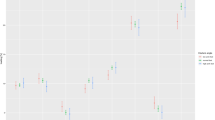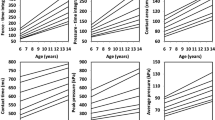Abstract
OBJECTIVE: This study examined the effects of obesity on plantar pressure distributions in prepubescent children.
DESIGN: Field-based, experimental data on BMI (body mass index), foot structure and plantar pressures were collected for 13 consenting obese children and 13 non-obese controls.
SUBJECTS: Thirteen obese (age 8.1±1.2 y; BMI 25.5±2.9 kg/m2) and 13 non-obese (age 8.4±0.9 y; BMI 16.9±1.2 kg/m2) prepubescent children, matched to the obese children for gender, age and height.
MEASUREMENTS: Height and weight were measured to calculate BMI. Static weight-bearing footprints for the right and left foot of each subject were recorded using a pedograph to calculate the footprint angle and the Chippaux–Smirak index as representative measures of the surface area of the foot in contact with the ground. Right and left foot plantar pressures were then obtained using a mini-emed® pressure platform to calculate the force and pressure experienced under each child's foot during static and dynamic loaded and unloaded conditions.
RESULTS: Obese subjects displayed significantly lower footprint angle (t=4.107; P=<0.001) values and higher Chippaux–Smirak index values (t=−6.176; P=<0.001) compared to their non-obese counterparts. These structural foot changes were associated with differences in plantar pressures between the two subject groups. That is, although rearfoot dynamic forces generated by the obese subjects were significantly higher than those generated by the non-obese subjects, these forces were experienced over significantly higher mean peak areas of contact with the mini-emed® system. Therefore, rearfoot pressures experienced by the two subject groups did not differ. However, the mean peak dynamic forefoot pressures generated by the obese subjects (39.3±15.7 N·cm−2; q=3.969) were significantly higher than those generated by the non-obese subjects (32.3±9.2 N·cm−2).
CONCLUSIONS: It is postulated that foot discomfort-associated structural changes and increased forefoot plantar pressures in the obese foot may hinder obese children from participating in physical activity and therefore warrants immediate further investigation.
This is a preview of subscription content, access via your institution
Access options
Subscribe to this journal
Receive 12 print issues and online access
$259.00 per year
only $21.58 per issue
Buy this article
- Purchase on Springer Link
- Instant access to full article PDF
Prices may be subject to local taxes which are calculated during checkout





Similar content being viewed by others
References
Jahss MH . Disorders of the foot WB Saunders Company: Philadelphia 1982.
Ker RF, Bennett MB, Bibby SR, Kester RC, Alexander RMcN . The spring in the arch of the human foot Nature 1987 325: 147–149.
Platzer W . Locomotor system Georg Thieme: Stuttgart 1992.
Cavanagh PR, Kram R . Stride length in distance running: velocity, body dimensions, and added mass effects Med Sci Sports Exerc 1989 21: 467–479.
Kram R, McMahon TA, Taylor CR . Load carriage with compliant poles—physiological and/or biomechanical advantages? J Biomech 1987 20: 893.
Martin PE . Mechanical and physiological responses to lower extremity loading during running Med Sci Sports Exerc 1985 17: 427–433.
Nyska M, Linge K, McCabe C, Kienerman L . The adaptation of the foot to heavy loads plantar foot pressures study In: Cavanagh P (ed). Proceedings of the V Emed Scientific Meeting Pennstate: Pennsylvania 1996.
Gehlsen GM, Seger A . Selected measures of angular displacement, strength, and flexibility in subjects with and without shin splints Res Q Exerc Sport 1980 51: 478–485.
Messier SP, Davies AB, Moore DT, Davis SE, Pack RJ, Kazmar SC . Severe obesity: effects on foot mechanics during walking Foot Ankle Int 1994 15: 29–34.
Viitasalo JT, Kvist M . Some biomechanical aspects of the foot and ankle in athletes with and without shin splints Am J Sports Med 1983 11: 125–130.
Riddiford‐Harland DL, Steele JR, Storlien LH . Does obesity influence foot structure in prepubescent children? Int J Obes Relat Metab Disord 2000 24: 541–544.
Hammer LD, Kraemer HC, Wilson DM, Ritter PL, Dornbusch SM . Standardised percentile curves of body-mass index for children and adolescents Am J Dis Children 1991 145: 259–263.
Forriol F, Pascual J . Footprint analysis between three and seventeen years of age Foot Ankle Int 1990 11: 101–104.
National Health & Medical Research Council . Statement on human experimentation NHMRC: Australia 1993.
Wu KK . Foot orthoses. Williams & Wilkins: Baltimore, MD 1990.
Hennig EM . Measurement and evaluation of loads on the human body during sports activities In: Riehle HJ, Vieten MM (eds). Proceedings I of the XVI International Symposium on Biomechanics in Sports UVK-Univesitätsverlag: Konstanz 1998 399–402.
Meyer-Rice B, Sugars L, McPoil T, Cornwall MW . Comparison of three methods for obtaining plantar pressures in nonpathologic subjects JAPMA 1994 84: 449–504.
Hennig EM, Staats A, Rosenbaum D . Plantar pressure distribution patterns of young school children in comparison to adults Foot Ankle Int 1994 15: 35–40.
Smahel Z . Effects of body weight on the configuration of the plantar arch (planimetric study) Hum Biol 1980 52: 449–57.
Norkin CC, Levangie PK . Joint structure and function F.A. Davis: Philadelphia, PA 1992.
Author information
Authors and Affiliations
Corresponding author
Rights and permissions
About this article
Cite this article
Dowling, A., Steele, J. & Baur, L. Does obesity influence foot structure and plantar pressure patterns in prepubescent children?. Int J Obes 25, 845–852 (2001). https://doi.org/10.1038/sj.ijo.0801598
Received:
Revised:
Accepted:
Published:
Issue Date:
DOI: https://doi.org/10.1038/sj.ijo.0801598
Keywords
This article is cited by
-
The resting calcaneal stance position (RCSP): an old dog, with new tricks
European Journal of Pediatrics (2023)
-
Children’s foot parameters and basic anthropometry — do arch height and midfoot width change?
European Journal of Pediatrics (2022)
-
The relationship between paediatric foot posture and body mass index: do heavier children really have flatter feet?
Journal of Foot and Ankle Research (2015)
-
Foot loading patterns in normal weight, overweight and obese children aged 7 to 11 years
Journal of Foot and Ankle Research (2013)
-
Foot morphology in normal-weight, overweight, and obese schoolchildren
European Journal of Pediatrics (2013)



